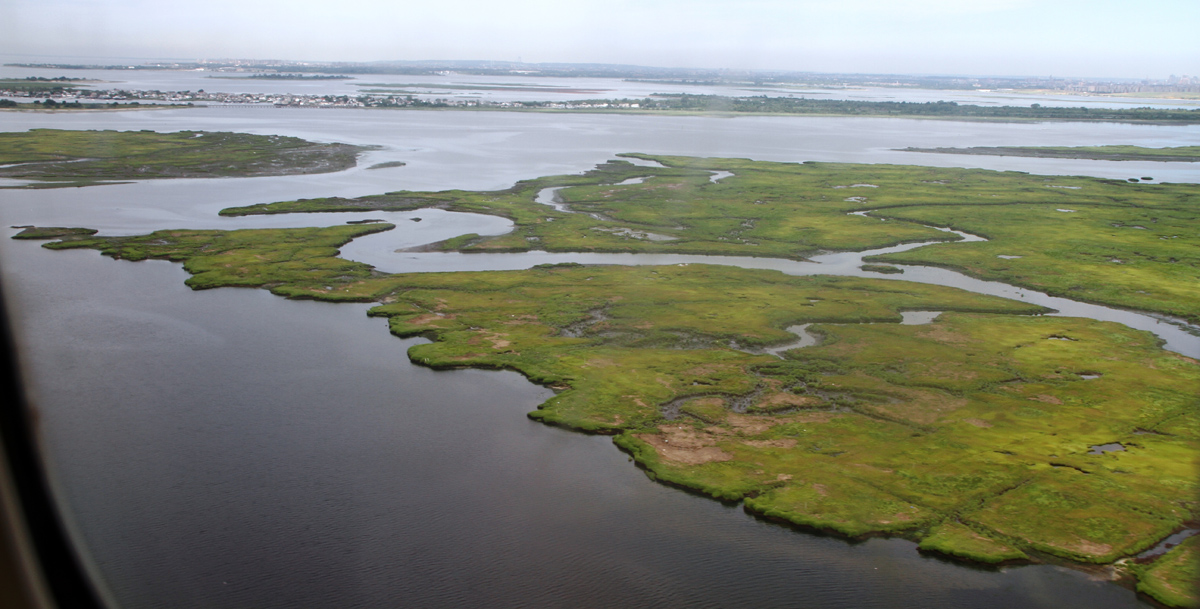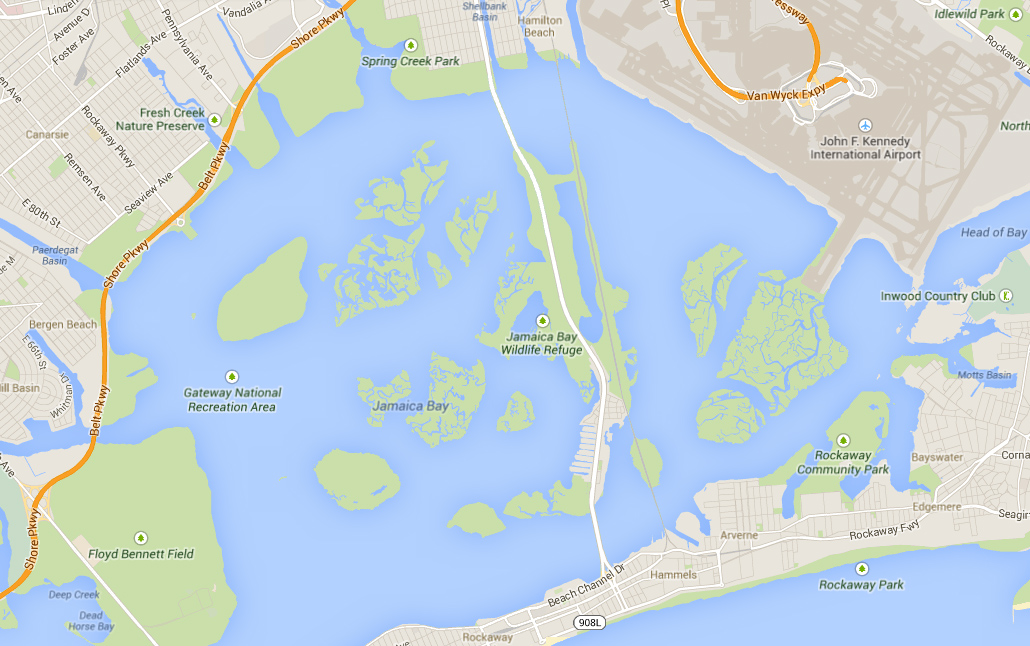
The meeting place of the new Science and Resilience Institute at Jamaica Bay used to be an airport. That the former Floyd Bennett Field now hosts information about the surrounding parkland and wildlife perhaps hints at the kind of flexible ‘resilience’ for which the institute aims. Resilience is not necessarily about preserving a landscape as it is today, in a fixed form, forever. It’s about understanding an area, and then managing it so that the valuable and integral qualities can continue despite environmental and human pressures.
Jamaica Bay is divided between Long Island and Queens. It is naturally a wetland but longtime development in the area, including the construction of Floyd Bennett Field and later JFK, the international airport that followed, caused destructive dredging, filling, and pollution of the Bay. It doesn’t adequately support many kinds of aquatic and bird populations anymore, but given that nearly 1 million New Yorkers live in the Jamaica Bay watershed, the stability of its ecosystem is important not only to wildlife, but to people. Hurricane Sandy had intense and lasting impacts on both the Bay and its surrounding communities, such as the Rockaways.
The Science and Resilience Institute at Jamaica Bay (SRI@JB), a CUNY initiative formed last year under Mayor Bloomberg, aims to study and enhance urban resilience. The work of the Institute will benefit not only Jamaica Bay, but the billions of people living in fragile urban ecosystems all over the world.
This June, the Institute met to develop a report on resilience practice which will be published later this year. Dr. William Solecki, director of the CUNY Institute for Sustainable Cities, City Atlas advisor, and director of the SRI@JB, led the scientists, academics, and urban planners who had gathered from many institutions, including Rutgers, Cornell, the Stevens Institute for Technology, the Parks Department, FEMA, and the Wildlife Conservation Society. Lead authors of each chapter of the upcoming report presented. Then, workshop attendees divided into breakout groups to discuss how to best move forward with each chapter.
The first chapter of the report will discuss resilience practice in urban watersheds. This chapter provides the context for how Jamaica Bay studies can inform policy for the upper bay, the lower bay, and many other urban watersheds. It uses the definition of resilience as “the capacity of a system to experience shocks while retaining essentially the same function, structure, feedbacks, and therefore identity.” This was the central question of the day: resilience of what to what.

What is the Institute hoping to protect or manage? Should ecological or social resilience be the focus? Do we want to increase oyster populations or flood protection for residents? Of course is impossible to separate these kinds of variables, because changes like an increase in oysters can mean better flood protection for residents, while more residents can mean decreased oyster populations.
[pullquote align=”right”]Slow changes, like urbanization, have influenced the Bay more than dramatic disturbances like Hurricane Sandy. [/pullquote]In addition to deciding what parts of Jamaica Bay we value, we also have to decide what the disturbances are. Slow changes, like urbanization, have influenced the Bay more than dramatic disturbances like Hurricane Sandy. You can recognize the impact of a slow disturbance when the function of some part of the system is disrupted (For example, if the marshes collapse, that will disrupt the Bay’s function as a habitat for striped bass, among many other organisms. But the key disturbance isn’t the marsh collapse, it’s the imbalanced nitrogen, hydrogen sulfide, or problems with sediment which then cause the marsh collapse.)
Another major challenge of the report is deciding how to make it most useful for the community, especially as one major goal of the Institute is to engage with and protect the people who live in the Jamaica Bay watershed. One attendee, who has worked with those living in the Rockaways since Hurricane Sandy, pointed out that most of the public doesn’t even know what resilience means. She said that there is a great amount of fear and mistrust in the area, especially among those who are not well informed about what’s going on. But the data is not getting to the most vulnerable populations, and when these people do try to participate, their contributions are shut out because they are thinking in a shorter time frame than the scientists. She said that, “At the end of the day, people want to know, ‘Should I move? Should I stay?’ ‘Should I raise my house up by 12 feet…or not?’” Nitrogen or hydrogen sulfide levels may be important parts of the answers to these questions, but they may not be crucial parts of the education the Institute should provide to the community.
The leadership of the Institute is dedicated to outreach. Participants have been working with their database of 400 community organizations to use existing community structures to communicate with and learn from the people in and surrounding the Bay. Researchers for the Institute have interviewed community residents and leaders, and conducted presentations to open a dialogue with the public.
As one workshop participant said, it’s important that the community doesn’t think, “Oh, they’re just going to study it to death instead of doing anything.” This public contact underlines the importance of the work going on at SRI@JB; observing, learning, and finding solutions to one of the most pressing problems of our age—finding better ways to protect people and nature in coastal communities.